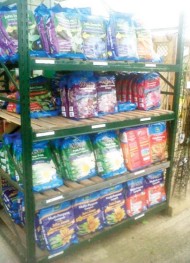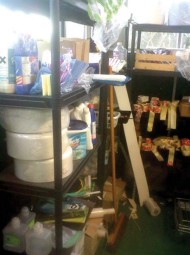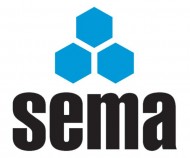 The first question this month looks at two issues that were raised during a site audit and the second is asking about the testing procedure for cantilever racking after it has been moved to a new location.
The first question this month looks at two issues that were raised during a site audit and the second is asking about the testing procedure for cantilever racking after it has been moved to a new location.
Racking or Furniture?
Q. I have had an enquiry from our auditors as to whether racking of the type shown in the pictures attached are required to have weight or loading warning sign notices attached to them.
A. You are on the fringes of what might be viewed as furniture and what might be viewed as storage racking so it really boils down to your formal risk assessment for the installation.
The view might be taken that the display racking in the garden centre could be loaded by a variety of people who have not been briefed about the allowable carrying capacity of the rack (even if your company has that information to hand) and they need to know what load they can put on the rack safely. For instance this rack could be displaying bags of sand and gravel tomorrow and the staff who are called on to prepare the display need the information on carrying capacity to be able to do this safely, quite apart from the danger to your customers who will be picking goods from a rack of unspecified carrying capacity. Normally your supplier of racking should provide load notices with the product as he has a duty of care to tell you how to use the racking you have bought from him safely.
The other alternative of course is to specify racking of such a duty that it is impossible to overload it with the goods that you have on sale. I now anticipate that you will tell me you sell lead flashings for greenhouses and cold frames!
On the other hand the shelving in a cleaners cupboard which is always kept locked (I assume) apart from when a cleaner is using it might be a much lower risk because all the items in the cupboard are light weight. Having said this I have come across situations where for economy cleaning fluids are suddenly supplied in 25 or 30 litre containers which are substantial weights and are then placed on the shelving. Potential collapses of shelving carrying large quantities of possibly harmful cleaning fluids is a risk that cannot be ignored. If this risk cannot be managed adequately then placing a load notice on this shelving so that operators understand what is allowed and what is not might be very sensible.
Cantilever rack maintenance
Q. We are looking to move a few of our cantilever racks at the factory and wish to have it fully tested prior to use.
A. It is not normal to carry out a load test on re located racking for two reasons. The first is that it is very expensive to do this and secondly if a failure occurs during the test then it can also be dangerous. Even if failure does not occur then the rack is being taken close to failure point some damage may result which might not be noticeable during the course of the test. Normally we test components of rack structures in order to develop manufacturers load tables.
 What is more normal is that if the original manufacturer of the racking can be identified then they would be asked to confirm that it is re-built in accordance with recommendations and a new load sign would be produced based on manufacturers load tables.
What is more normal is that if the original manufacturer of the racking can be identified then they would be asked to confirm that it is re-built in accordance with recommendations and a new load sign would be produced based on manufacturers load tables.
If the manufacturer cannot be identified there are certain consultants who would calculate carrying capacities from first principles and place a certified load plaque on the rack based on these calculations.
The consultant approach is likely to be more expensive however in the absence of being able to identify an original supplier it is often the only option.
SEMA is delighted to be working with WLN on the storage Question and Answer Column which is published in WLN on a monthly basis. On the WLN website is a list of previously published columns which we hope you find useful.
Please note that SEMA Users Club members also have access to a comprehensive range of additional storage related questions and answers.
SEMA Technical Enquiries
We hope you find the above articles, and those in previous editions, interesting. If you have a query send it to us and we will do our best to have it answered by one of our experts.
SEMA Rack Safety Awareness and Inspection Courses
SEMA runs a one-day safety course on Rack Safety Awareness and Inspection. These courses are aimed at end users, giving an in-depth look at the need for inspections, how to conduct an assessment and what actions to take when this is completed.
SEMA Approved Rack Inspectors Qualification
This qualification is aimed at professionals who conduct rack surveys as an integral and significant part of their duties. It involves delegates in undertaking an in-depth SEMA Course, together with an examination and practical assessment. CPD will be an important part of the qualification, demonstrating to end users that SEMA Approved Inspectors maintain a high professional standard.
SEMA Publications
SEMA has 26 publications in stock -Codes of Practice, ‘Guides’ and European documents – all of which are available from our Offices.
SEMA runs a USERS Club designed to be of benefit to purchasers and users of storage equipment. Members receive newsletters, access to specialised events and discounted rates on publications and codes of practice.
For more info, www.sema.org.uk





Comments are closed.